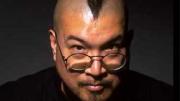Chinese-American jazz saxophonist, composer, writer, and self-described “radical, revolutionary artist” Fred Ho '79 will receive a Harvard Arts Medal on November 13, an unusual conferral of such an honor, which is typically made in the spring at Arts First.
Harvard Magazine's profile of Ho, "Chords of Revolution," began, vividly:
Fred Ho ’79 has never owned a car, nor is he “married with children.” No boss dictates his workday, and he buys very little. He has not even stepped into a clothing store in more than 12 years because he designs his own apparel, though he generally prefers to be naked. “What I create is better than Armani, better than Ralph Lauren, better than these boring mass marketers,” says Ho, whose signature piece is a fire-engine-red silk duster patterned with white cranes, made from a recycled Japanese wedding kimono. “I am not a Luddite and I don’t subscribe to purist positions regarding consumer capitalism. I just choose to consume something better.”
The news release about the award also announces a concert with the Harvard Jazz Bands on the following day, featuring the world premiere of Ho's "Take the Zen Train."









